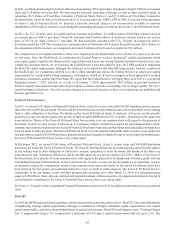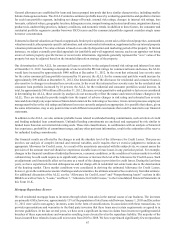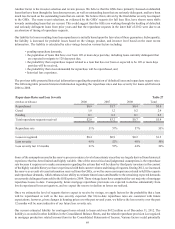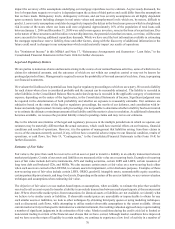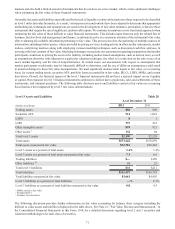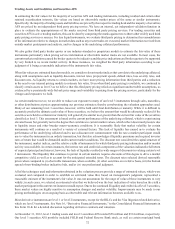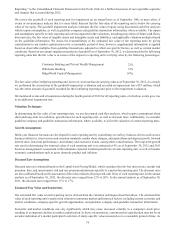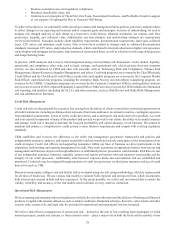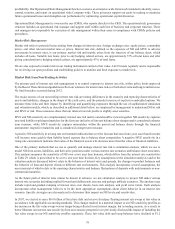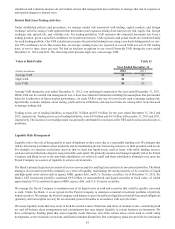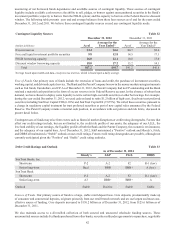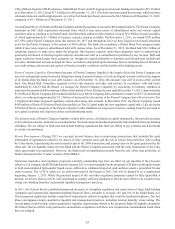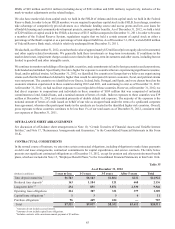SunTrust 2012 Annual Report Download - page 91
Download and view the complete annual report
Please find page 91 of the 2012 SunTrust annual report below. You can navigate through the pages in the report by either clicking on the pages listed below, or by using the keyword search tool below to find specific information within the annual report.75
a result, the use of market capitalization is a less relevant measure to assess the reasonableness of the aggregate value of the
reporting units. Therefore, we supplement the market capitalization information with other observable market information
that provided benchmark valuation multiples from transactions over a reasonable period.
The estimated fair value of the reporting unit is highly sensitive to changes in these estimates and assumptions; therefore, in
some instances, changes in these assumptions could impact whether the fair value of a reporting unit is greater than its carrying
value. We perform sensitivity analyses around these assumptions in order to assess the reasonableness of the assumptions and
the resulting estimated fair values. Ultimately, future potential changes in these assumptions may impact the estimated fair
value of a reporting unit and cause the fair value of the reporting unit to be below its carrying value. Additionally, a reporting
unit's carrying value of equity could change based on market conditions and the risk profile of those reporting units.
If there is a situation where the carrying value of equity exceeds the estimated fair value, an additional goodwill impairment
evaluation is performed that involves calculating the implied fair value of the reporting unit's goodwill, which is determined
in the same manner as goodwill is recognized in a business combination.
The value of the implied goodwill is highly sensitive to the estimated fair value of the reporting unit's net assets. The fair
value of the reporting unit's net assets is estimated using a variety of valuation techniques including the following:
• recent data observed in the market, including similar assets,
• cash flow modeling based on projected cash flows and market discount rates,
• market indices,
• estimated net realizable value of the underlying collateral, and
• price indications from independent third parties.
Observable market information is utilized to the extent available and relevant. The estimated fair values reflect management's
assumptions regarding how a market participant would value the net assets and includes appropriate credit, liquidity, and
market risk premiums that are indicative of the current environment.
If the implied fair value of the goodwill for the reporting unit exceeds the carrying value of the goodwill for the respective
reporting unit, goodwill is not impaired. If the carrying amount of a reporting unit's goodwill exceeds the implied goodwill,
an impairment loss is recognized in an amount equal to the excess. Changes in the estimated fair value of the individual assets
and liabilities may result in a different amount of implied goodwill, and ultimately, the amount of goodwill impairment, if
any. Sensitivity analysis is performed to assess the potential ranges of implied goodwill.
Income Taxes
We are subject to the income tax laws of the U.S., its states and municipalities where we conduct business. We estimate income
tax expense based on amounts expected to be owed to these various tax jurisdictions. The estimated income tax expense or
benefit is reported in the Consolidated Statements of Income.
Accrued taxes represent the net estimated amount due to or to be received from tax jurisdictions either currently or in the
future and are reported in other liabilities on the Consolidated Balance Sheets. In estimating accrued taxes, we assess the
appropriate tax treatment of transactions and filing positions after considering statutes, regulations, judicial precedent, and
other pertinent information. The income tax laws are complex and subject to different interpretations by the taxpayer and the
relevant government taxing authorities. Significant judgment is required in determining the tax accruals and in evaluating our
tax positions, including evaluating uncertain tax positions. Changes in the estimate of accrued taxes occur periodically due
to changes in tax rates, interpretations of tax laws, the status of examinations by the tax authorities, and newly enacted statutory,
judicial, and regulatory guidance that could impact the relative merits and risks of tax positions. These changes, when they
occur, impact tax expense and can materially affect our operating results. We review our tax positions quarterly and make
adjustments to accrued taxes as new information becomes available.
Deferred income tax assets represent amounts available to reduce income taxes payable in future years. Such assets arise due
to temporary differences between the financial reporting and the tax bases of assets and liabilities, as well as from NOL and
tax credit carryforwards. We regularly evaluate the realizability of DTAs. A valuation allowance is recognized for a DTA if,
based on the weight of available evidence, it is more likely than not that some portion or all of the DTA will not be realized.
In determining whether a valuation allowance is necessary, we consider the level of taxable income in prior years to the extent
that carrybacks are permitted under current tax laws, as well as estimates of future pre-tax and taxable income and tax planning
strategies that would, if necessary, be implemented. We currently maintain a valuation allowance for certain state carryforwards
and certain other state DTAs. We expect to realize our remaining federal and state DTAs over the allowable carryback and/
or carryforward periods. Therefore, no valuation allowance is deemed necessary against our federal or remaining state DTAs


